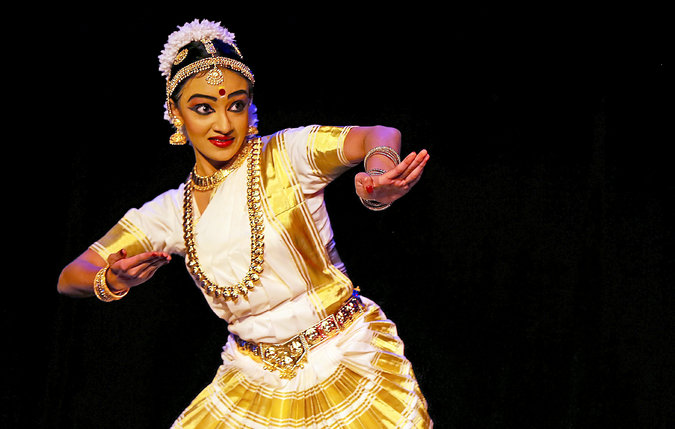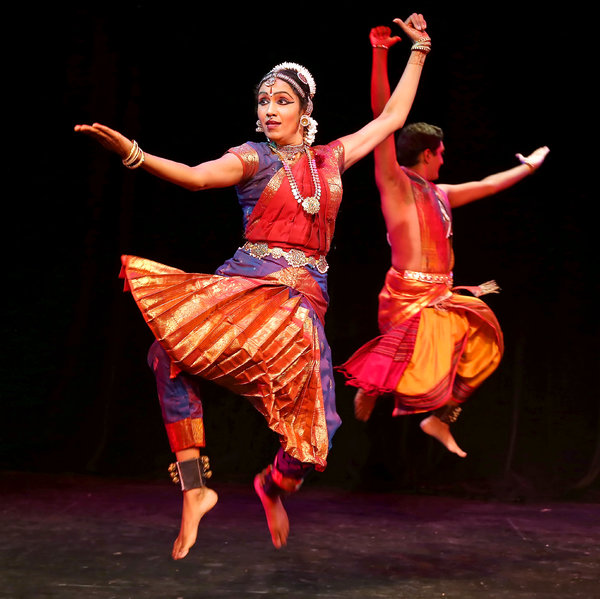|
| |
| Erasing Borders Festival of Indian Dance : Outdoor Festival |
| Reveiws |
|
| |
nytimes.com
To Become Another Being
Indian Dance and Music at the Drive East Festival
By ALASTAIR MACAULAYAUG. 14, 2014
|
| |

Suryavarshita Kuchi of the Smitha Rajan & Company, performing as part of the Drive East festival at La MaMa. Credit Andrea Mohin/The New York Times |
| |
|
At the current one-week Drive East festival of Indian dance and music at La MaMa, each artist or group has just one performance. Several of the performers are little known. You just have to go along, take a risk and learn from them all. The quality is high; the styles are varied. Some of the music has been even better than the dance - perhaps because almost all of the dance has been to taped music, whereas the recitals by instrumentalists, bands and singers have filled the act of music-making with delight and immediacy.
Even so, the dance has brought many moments of revelation. Among the marvels of most forms of Indian classical dance is the way in which a single dancer slips from emotion to emotion, from character to character. Although English-speaking audiences are usually told who the characters are and how their stories will unfold, itís normally more than we can take in - and yet that scarcely matters when the dancing begins.
The performers donít so much enact a narrative as give it a series of illustrations, and the vivid, seamless way in which they shuttle between feelings and temperaments takes us deep into the mystery of acting and identity. Opera people often - and rightly - remark on the marvelous films of the soprano Maria Callas in concert; they show us the very moment when her whole face subtly switches into the character she is about to sing. It feels miraculous. Yet such moments keep recurring during individual Indian dances: the face changes contour; the body becomes another being.

Andrea Mohin/The New York Times |
Smitha Rajan is not one of the great beauties of Indian dance, but who on Wednesday night could have taken their eyes off her for a second? Her very eyebrows vibrate, the corners of her mouth quiver, and the constantly changing life of her eyes commands attention. This acting isn’t confined to her face; her whole breathing and stance are involved, and I was startled to notice on several occasions the force with which she threw her pelvis into various points of emphasis. And this is musical acting, phrased to its accompaniment with legato fluency.
Ms. Rajan, though she lives in Missouri, practices the Mohiniattam style from the southwestern Indian state Kerala; she has practiced this for over three decades, having first learned it from her mother, Sreedevi Rajan, and having first performed it at 6. She brought with her three young female students; all four were dressed in white and gold.
The standard adjectives for Mohiniattam dance are “swaying” and “circular”; you soon see why. These women continually sway their torsos from side to side, giving a powerful and sensuous lilt to the dance; they travel around the stage in arcs, sometimes in full circles. There isn’t the metric complexity of Bharatanatyam (the classical genre of India’s southeastern state Tamil Nadu), but in one solo the curvaceous intricacy of Ms. Rajan’s dancing became a gorgeous overlap of S-bends from ankle to thigh, from knee to shoulder, from hip to hand.
And until this recital I had not known Mohiniattam’s potential for dramatic expression. In monologues, Ms. Rajan in a moment switched from enraged hostility to defeated suffering, from hearty laughter to modest shyness, from entreaty to adoration.

Andrea Mohin/The New York Times |
Her students performed a little story about the young Lord Krishna with spellbinding charm. The story concerns how he, playing as a boy, stuffed his mouth with mud. His brother reported his naughty antics to their mother, but when she demanded to look inside his mouth, she marveled to see that it contained the waters of a whole river, and she fell in awe to the floor.
What was delectable was the concision and fragmentation with which the tale was told. At times, as in some Western Renaissance paintings, we saw different sequences of the story occurring simultaneously on different parts of the stage. But the dancers did not look each other in the eye - so that Krishna’s mother looked not directly at Krishna but instead showed us the act of looking at him.
Similar elements of fast-mutating expression were to be found in the two Bharatanatyam recitals of Anjal Chande and Ramya Ramnarayan on Tuesday evening. Ms. Chande, with a wonderfully fresh and lovely face, is a gifted stylist, but her material, though accompanied by philosophical statements about nature and empowerment, tends to be sweetly bland. Ms. Ramnarayan, who performed with her son Rangaraj Tirumalai, delivered a far wider selection of the physical, rhythmic and communicative range of her idiom. Mr. Tirumalai, a broad-shouldered young man, has presence but not yet stylistic confidence; there is a tension in the way he holds his head that holds him back. The soles of Ms. Ramnarayan’s smaller feet often slapped the floor with greater impact than his, and her rhythm had terrific authority.
To study most of the Indian arts is to wonder about the many East-West cross-fertilizations that must have occurred over the centuries - some perhaps going back to Alexander the Great’s invasion of the Indian subcontinent. Seeing these dances the week after the New York performances of Mark Morris’s “Acis and Galatea,” I realize that Mr. Morris’s use of gestural motifs takes much from the dances of India, a country he has repeatedly visited. I wonder anew about the absorption of Merce Cunningham in the styles and philosophies of India from the 1940s on, some of which is still coming to light.
There are surprisingly numerous ballets by Frederick Ashton (from “The Wise Virgins” to the “Thaïs” Méditation) containing features of line and gesture that seem specifically Indian. Several of ballet’s mime monologues (Berthe’s in “Giselle,” Lise’s in “La Fille Mal Gardée”) come remarkably close to the abhinaya, expressive acting, of Indian dance tradition. Who knows who influenced whom and when? Meanwhile, each Indian dance abounds in distinctly non-Western points that enrich our minds and senses.
It’s marvelous how much Indian dance is reaching New York and other American cities. From Sunday to Thursday, the Battery Dance Company presents its annual Downtown Dance Festival. As happens each year, one day of this - Wednesday - will consist solely of the Erasing Borders Festival of Indian Dance, an event in which I’ve always delighted and from which I’ve learned much. Several classical styles - Kathak, Kathakali, Kuchipudi, Manipuri, Odissi, Sattriya - will be shown. The Battery Dance festival, held this year from 6 to 8 p.m. each day in Robert F. Wagner Park, also showcases an admirably catholic selection of other dance styles, from the Vanaver Caravan’s tribute to Pete Seeger to the American debut of the Romanian company Tangaj Dance. |
URL: http://www.nytimes.com/2014/08/15/arts/dance/indian-dance-and-music-at-the-drive-east-festival.html?smid=fb-share&_r=0 |
| |
|
|
|

